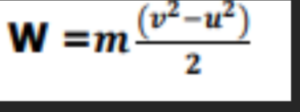Table of Contents
Kinetic energy is a fundamental concept in physics that describes the energy an object possesses due to its motion. It is one of the two main forms of mechanical energy, along with potential energy.
Kinetic energy is defined as the work needed to accelerate a body of a given mass from rest to its stated velocity. Kinetic energy depends on the velocity and mass of the body. If the velocity of an object is zero then its kinetic energy is also zero.
Example 1: A hammer is a tool that utilizes Kinetic energy to do work. The Kinetic energy of a moving hammer gives the hammer its ability to apply a force to a nail in order to cause it to be displaced.
Example 2: The Kinetic energy of a moving bowling ball gives the ball the ability to apply a force to a bowling pin in order to cause it to be displaced.
Example 3: High-speed winds are used to do work on the blades of a turbine at the so-called wind farm. The Kinetic energy of the moving air gives the air particles the ability to apply a force and cause a displacement of the blades.
Derivation of Formula of Kinetic Energy:
Consider an object of mass ‘m’ at rest. Suppose a force ‘F’ is applied to this body such that it is displaced by a distance ‘s’ and reaches a velocity ‘v’. The work done on the body ‘W’ will be given as,
W = F ✕ s
Force ‘F’ can be written as,
F = m ✕ a
Thus, the work done will be equal to,
W = ma ✕ s
We also know the equations of motion and according to the third equation of motion,

Now, on substituting the value of ‘as’ in the equation of work done, we get,

Since, the body was at rest, ‘u’ will be zero. Also the work done is nothing but equal to the change in kinetic energy we can substitute ‘W’ by ‘K.E.’

Hence an object of mass m moving with uniform velocity v possess Kinetic energy equals to,

Key points about kinetic energy
Kinetic Energy Relationship with Speed: Kinetic energy is directly proportional to the square of an object’s velocity. This means that as the speed of an object increases, its kinetic energy increases exponentially. For example, doubling the speed of an object will result in four times the kinetic energy.
Kinetic Energy Dependence on Mass: The kinetic energy of an object is also influenced by its mass. Objects with larger masses possess more kinetic energy than objects with smaller masses, assuming they have the same velocity. This is because the mass is directly proportional to the amount of matter in an object, which affects its overall energy content.
Units of Kinetic Energy: The SI unit of kinetic energy is the Joule (J).
The Joule is defined as the work done when the force of one Newton acts on an object and displaces it by one meter.
Solved Examples of Kinetic Energy Formula:
Example 1: A ball with a mass of 0.5 kilograms is rolling with a velocity of 10 meters per second. Calculate the kinetic energy of the ball.
Solution:
Given:
Mass of the ball (m) = 0.5 kg
Velocity of the ball (v) = 10 m/s
Step 1: Calculate the kinetic energy using the formula:
Kinetic Energy (KE) = 1/2 x mass x velocity2
KE = 1/2 x 0.5 x 10 2
KE = 1/2 x 0.5 kg x 100
KE = 0.25 kg x 100
KE = 25 Joules (J)
Therefore, the kinetic energy of the ball is 25 Joules (J).
Example 2: Calculate the work required to be done to increase the velocity of an object from 20 km/hr to 40 km/hr, if the mass of the object is 40 kg.
Solution: We know that the S.I. unit of velocity is m/s, hence we need to convert the given velocities into m/s.
Initial velocity:
u = 20 x (1000/60 x 60)
u = 5.55 m/s
Final velocity:
v = 40 x (1000/60 x 60)
v = 11.1 m/s
Initial kinetic energy:
K.E (initial) = (m x u2) / 2
K.E (initial) = 616 Joules
Final kinetic energy:
K.E (Final) = (m x v2) / 2
K.E (Final) = 2469 Joules
Work Done = Final Kinetic Energy – Initial kinetic energy
Work done = 1853 joule
Therefore, the work done will be equal to 1853 joules.
FAQ’s on Kinetic Energy Formula
What is kinetic energy?
Kinetic energy is the energy possessed by an object due to its motion. It is dependent on the object's mass and velocity. It is defined as the work required to accelerate an object of a certain mass from rest to its current velocity.
What is the formula for kinetic energy?
Kinetic energy is calculated using the formula: Kinetic Energy = 1/2 x mass x velocity2.
What are the units of kinetic energy?
The SI unit of kinetic energy is the Joule (J). However, it can also be expressed in other units such as electron volts (eV) or foot-pounds (ft-lb), depending on the context.
What are the examples of kinetic energy?
A moving car: The car possesses kinetic energy due to its motion. The energy depends on its mass and velocity. A ball in motion: When a ball is thrown or rolling, it possesses kinetic energy associated with its movement. Wind: Moving air molecules have kinetic energy, which can be harnessed for wind energy generation. Flowing water: Water in rivers or streams possesses kinetic energy, which can be used to generate hydroelectric power.
Does kinetic energy depend on direction?
yes, kinetic energy is a scalar quantity and does not depend on direction. It only depends on the magnitude of an object's velocity.
Is kinetic energy a vector?
No, kinetic energy is not a vector quantity. It is a scalar quantity. Scalar quantities are described by magnitude alone and do not have a specific direction associated with them. Kinetic energy represents the energy of an object in motion and is determined solely by its mass and velocity. It does not have a directional component like vector quantities, such as velocity or force, which have both magnitude and direction. Therefore, kinetic energy is a scalar quantity that represents the amount of energy possessed by an object due to its motion, without regard to its direction.
How does mass affect kinetic energy?
Kinetic energy is directly proportional to the mass of an object. Doubling the mass of an object will result in twice the kinetic energy, assuming the velocity remains constant.
How does velocity affect kinetic energy?
Kinetic energy is directly proportional to the square of an object's velocity. Increasing the velocity of an object will have a greater impact on its kinetic energy compared to an increase in mass.
Can kinetic energy be negative?
No, kinetic energy is always a positive value or zero. It represents the energy associated with the motion of an object and cannot be negative.
What is the relationship between work and kinetic energy?
The work-energy theorem states that the work done on an object is equal to the change in its kinetic energy. When work is done on an object, it can result in a change in its kinetic energy.



